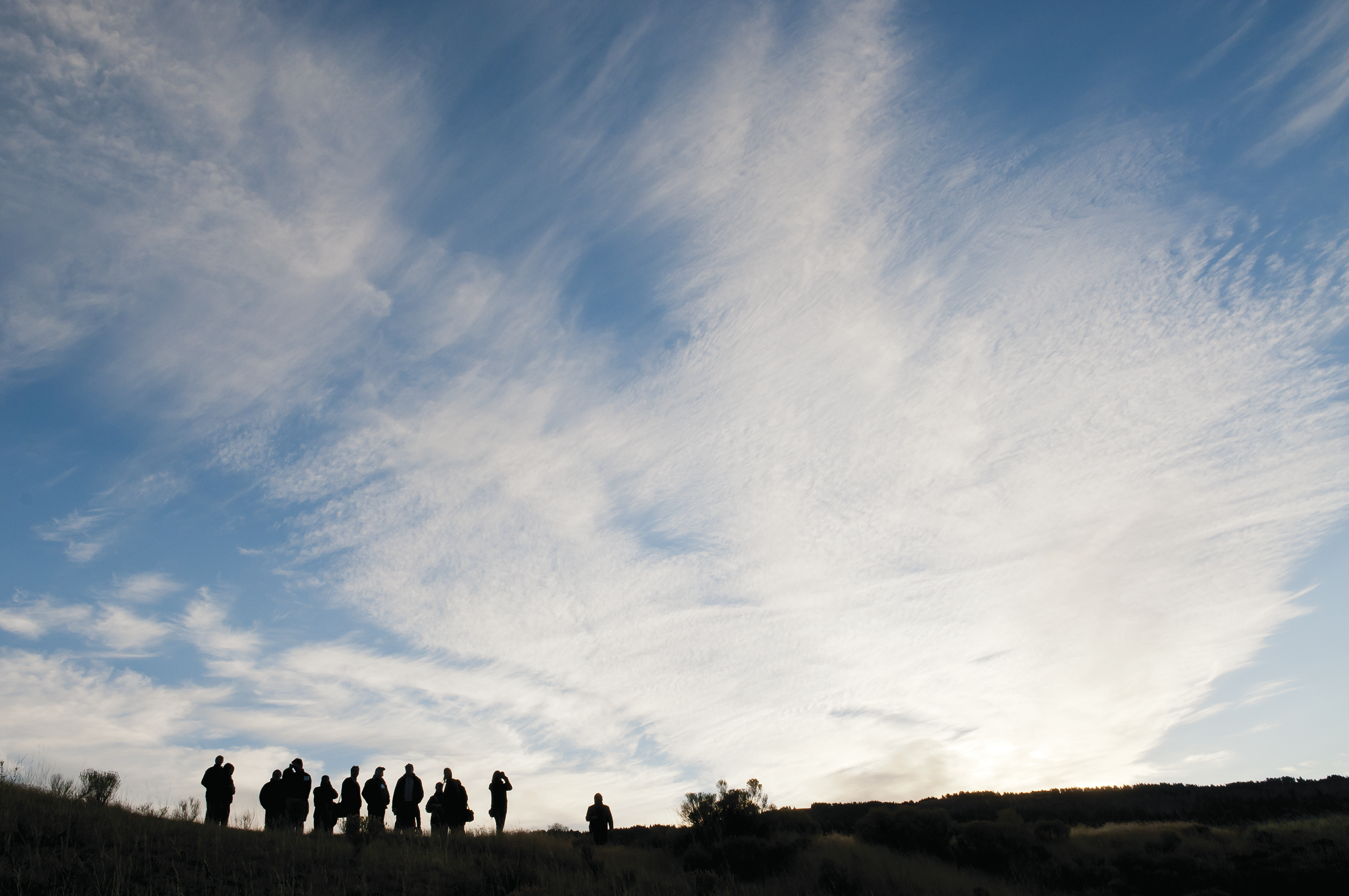
01 Sep A Yellowstone Charrette
ROOSEVELT ARCH MAY NOT COMMAND THE GLOBAL PROFILE OF, SAY, PARIS' ARC DE TRIOMPHE, Berlin’s Brandenburg Gate or London’s Wellington Arch. It may not radiate the same level of mystery as the threshold leading into Beijing’s Forbidden City or exude the ornate elegance of the Arch of Septimius Severus, part of the Roman Forum. But as a portal for Yellowstone, the world’s first national park, it was built to serve as a harmonious visual and philosophical passageway into a natural wonderland.
Unfortunately, Roosevelt Arch’s once prominent role in announcing the entrance to Yellowstone on the park’s northern boundary at Gardiner, Montana, is today catawampus, distantly removed from its original purpose by highway engineering.
In 1903 when the distinctive landmark was dedicated to honor President Theodore Roosevelt, who laid its cornerstone, the arch rose directly in front of a railway station designed by famed architect Robert Reamer, considered “the Frank Lloyd Wright of Yellowstone.”
As the stylistic godfather of rustic “parkitecture” in America, Reamer [1873–1938] was the creative genius behind Yellowstone’s iconic Old Faithful Inn; Lake Hotel situated on the shores of the national park’s largest tarn; and the long-vanished Canyon Hotel that rested near the Grand Canyon of the Yellowstone River.
Roosevelt Arch formed a perfect inspiring sightline for passengers getting off the train, moving beneath its pillars via stagecoach and reminding them that they were entering a preserve unlike any other. Yet with the advent of the auto age and, more significantly, the razing of the railroad depot, Roosevelt Arch no longer represents a potent point of demarcation for those reaching Gardiner on U.S. Highway 89.
Reduced to a side thought, the last century has transformed this historic stone structure from being a prized centerpiece into an out-of-place, underappreciated relic from another era.
So ponder this: What if Roosevelt Arch was moved and the course of the road slightly reconfigured? For stalwart traditionalists, such a question represents pure heresy. Perhaps a better inquiry is: Should history, even when it takes on dysfunctional qualities, be considered inviolate, or can it be updated to assume greater relevance in changing times?
Now before the National Park Service is that intriguing, mind-bending proposition that asks whether Roosevelt Arch, as an important architectural tool for accentuating the power of Yellowstone, can be restored?
Point of fact, Roosevelt Arch is hardly a singular conundrum. At nearly all of Yellowstone’s busy development hubs, auto parking lots, widened roads, expanding asphalt and structures erected to handle the crush of tourism have produced troublesome footprints. Their presence, experts say, not only detracts from Yellowstone’s aesthetic grandeur, but short-sightedness has trampled sensitive geothermal areas, run roughshod over wildlife habitat and sullied vistas that the crown jewel sanctuary was set aside specifically to protect.
A modest quest that started a few years ago to address those problems has become instead a novel exercise in brainstorming involving key Yellowstone planning staff, some of the most innovative architecture firms in the country and students at Montana State University in Bozeman. Soon, the public, too, may have a chance to enter the discussion of whether Yellowstone’s grid of development needs an overhaul and how it can be done to accommodate rising numbers of people while paradoxically lessening environmental impact.
“I don’t know of any other place in the National Park Service where this kind of out-of-the-box thinking is happening,” says Dan Wenk, who took the reins as Yellowstone Superintendent in 2011. “There is a great interest at the national planning level in Washington in terms of what we are doing here. Yellowstone could very well become a model.”
Consider: At Lake Hotel, tourists no longer arrive at the front of the guest lodge along Yellowstone Lake as architect Reamer intended. Instead, they pull into an unattractive parking lot that prevents them from even seeing the lake. In the same vicinity, dozens of historic cabins that played a crucial role in Yellowstone’s contribution to trout conservation are falling apart.
At Old Faithful, parking lots are nearly as large as the geothermal dimensions of Old Faithful Geyser itself. On any busy summer day, the scene around the world’s most venerable thermal fountain is more like stadium crowds flocking to a sporting event or amusement park. Actions are being discussed that could make Old Faithful more pedestrian friendly and peaceful.
At Mammoth Hot Springs, all traffic currently passes through the heart of the development, creating congestion and safety hazards that detract from the otherwise tranquil setting of historic Fort Yellowstone and the travertine terraces flanking park headquarters. A couple of discussions have involved routing pass-through traffic around Mammoth to facilitate a quieter and more relaxing setting.
While ideas currently on the table are conceptual, they could ultimately reshape the visitor experience parkwide — for the better. What’s poignant is that the process of introspection did not begin with the Park Service, but is credited to the catalytic influence of two citizens — both self-avowed “park lovers,” conservationists and players within the architectural movement of critical Western regionalism.
Their names: Paul Bertelli, principal at the nationally recognized design-build firm JLF Associates in Bozeman, Montana, and John Brittingham, a Harvard-educated professor in Montana State University’s College of Architecture.
Yellowstone officials admit that they were initially suspicious of Bertelli’s and Brittingham’s motivations. Given the sacred status that national parks have in American society, anything that could potentially challenge well-established management protocols attracts skepticism.
“Sometimes getting sets of outside eyes is exactly what we need,” superintendent Wenk says, noting that because Yellowstone is fixated on addressing short-term challenges, decision-makers “don’t often have the luxury of stepping far enough back and getting our arms wrapped around possible solutions to long-term problems.”
Bertelli, an MSU alum, wanted to give the park a broader view of how problems can be overcome by tapping into the philanthropic spirit of motivated private sector visionaries in place-based architecture. When clients approach him at his firm, they do so with immodest expectations. They want him and JLF to make their dreams come true. They want their desires met in four walls, in ways that reflect their values and leave them inspired.
JLF has won acclaim for its high-end custom homes wrought of distinctive recycled historic materials and personal touches. Normally what’s lacking among the people enlisting its services isn’t the will to do good by the land, Bertelli says; it’s the unfulfilled desire of clients to have their feet planted deeper in the earth, feeling spiritually grounded to a place and reconnecting themselves to important discoveries that have eluded them in a complicated world.
“Everyone wants a connection to something bigger, and architecture, when it’s done well, accomplishes that,” he says.
In many ways, it’s parallel to the assignment presented to Yellowstone architect Reamer when he set out to build distinctive grand edifices, drawn from local organic materials, designed to leave park visitors invigorated to be in the wilds.
One of the first things Bertelli does after a prospective client approaches him is take a site walk. For him, it is important that they have a discussion about place and the role of what he believes should be the highest virtue in architecture: Honoring the setting, not diminishing it through a misguided expression of human ego.
Similarly, when college students approach Brittingham aspiring to make a career in architecture, they, too, have immodest expectations. Brittingham says that many of them want to do what Bertelli does for a living. “Paul is a thinker who approaches his work by knowing not only what’s possible, but more essentially, what’s appropriate.”
Both men subscribe to Frank Lloyd Wright’s observation: “The mother art is architecture. Without an architecture of our own we have no soul of our own civilization.” The vernacular that Reamer established in Yellowstone, Bertelli says, is part of America’s soul, but it’s threatened by the impacts of industrial-strength tourism that numbs people to their surroundings rather than stoking their sensual awakening.
A few years ago, Bertelli and Brittingham took the equivalent of a professional site walk through Yellowstone, a place that remains a prominent reference point for modern place-based architecture. What they discovered, in applying discerning scrutiny to popular Yellowstone attractions, were buildings in various stages of disrepair and vast seas of asphalt that had swelled in size over decades in response to greater volumes of car traffic.
Places like Old Faithful and Yellowstone Lake, where Reamer had established a legacy of taste and timelessness, were overwhelmed by a pastiche of development that had grown incrementally and piecemeal during the 20th century.
“There is a profound disconnect that occurs in Yellowstone. You see it, but you feel it, too,” Bertelli says. “On the one hand you have these unforgettable marvels of nature that take your breath away and leave you in awe; on the other hand, the developments which contain some incredible human architecture can also seem chaotic and disorienting in ways that would leave guys like Reamer appalled.”
Eleanor Clark, Yellowstone’s senior landscape architect, agrees with Bertelli’s assessment. Of multiple conversations he’s had with Clark, Bertelli says, “When you talk with Eleanor, a couple of realities emerge. She and those in park operations are doing an extraordinary job of moving vast amounts of people through Yellowstone pretty seamlessly, and they’re accomplishing it in spite of enormous infrastructure challenges. What they struggle against, cloaked beyond sight of the average tourist, are severe limitations imposed on them by budget.”
Although Wenk gives the lion’s share of credit to his superintendent predecessor, Suzanne Lewis, for nurturing a creative re-examination of how major developments meet form and function, he has hit the ground running.
Wenk began his career as a ranger in Yellowstone three decades ago and witnessed Yellowstone’s most controversial development — Grant Village — grow on the south shore of Yellowstone Lake. He also oversaw the Park Service’s planning division, known as the Denver Service Center. Most apropos, Wenk served as superintendent of Mount Rushmore National Memorial, which recently underwent a massive architectural redesign. The purpose was to enhance visitor interaction with the hallowed site that features the faces of four U.S. presidents sculpted into a granite Black Hills cliff by Gutzon and Lincoln Borglum.
Bertelli became familiar with Yellowstone’s daunting architectural plight after visiting a researcher friend who was stationed at Yellowstone Lake, dispatching unmanned remote-controlled submarines to explore underwater geysers. Bertelli found buildings of historic value that were crumbling, yet without outside funding to save and manage them as part of a master plan, he was told that mounting a rescue was futile. That made him angry.
After many back-and-forth chats beginning in 2006, former superintendent Lewis told Bertelli and Brittingham that it would cost several hundred thousand dollars to develop a master plan for the Lake Historic District that encompasses hundreds of structures.
“I told Suzanne, ‘Don’t you worry about finding money; you don’t have to get outside help. I’ll take care of that,’” Bertelli said.
Relying on the reputation of his own firm and the network of Montana State University alumni dispersed across the country, he solicited help from established architects on both coasts and those doing commendable work in the Rockies.
As a result, Bertelli, Brittingham and Lewis hatched an uncommon strategy using design charrettes, or intense planning sessions, to bring passionate park resource professionals together with big-idea people from major firms. The effort has grown dramatically in scope, shining a light on the magnitude of problems affecting Yellowstone’s human-built environment. Before its eyes, Yellowstone also has won over an impressive group of stakeholders.
Lewis and Wenk are united in the belief that Yellowstone should offer an escape from the rat race of civilization and try to minimize the trappings of traffic congestion, urban noise and anxiety that visitors are trying to escape from. While humans are incapable of improving upon the magnificence of nature, the beauty of architecture, Bertelli says, is that it can be flexible. He notes that even Lake Hotel only became the beloved edifice it is today after Reamer gave its boring, first iteration a classical facelift. Development footprints can be downsized, and through smarter approaches can enhance the ambience of a place.
Over the last half decade, three charrettes have occurred at Yellowstone Lake, Old Faithful and Fort Yellowstone/Mammoth Hot Springs; each of them availed to the Park Service free of charge upwards of $600,000 worth of billable hours from private firms. With a few more charrettes in the pipeline, Yellowstone will have millions of dollars of free professional insight that it could not otherwise afford.
From the first charrette at Lake Yellowstone that attracted Mithun and Bohlin Cywinski Jackson from Seattle, Mosaic Architecture from Helena, Montana, and Verdone Landscape Architects and Carney Architects of Jackson Hole (the latter having designed the award-winning visitor center in Grand Teton National Park’s Rockefeller Preserve), it won the attention of firms ever farther afield, notes Christa Gertiser of JLF, who had been a crucial conduit between all of the various parties. At Old Faithful, OLIN Studio from Philadelphia, Landmarks Design Associates of Pittsburgh, Smith Group of Phoenix, Fentress Bradburn from Denver and Intrinsik from Bozeman joined in. And in the third installment at Mammoth, Dan Pohrte led a team from Chicago that was complemented by El Dorado from Kansas City, Henneberry Eddy Architects from Portland, Oregon, Living Places Design Studio from Bozeman and an array of brilliant artist members from the American Society of Architectural Illustrators.
All of the firms felt honored just to be asked to participate, to lend their expertise gratis in helping a national park they revere, Bertelli says. It’s about giving back, not taking; having an opportunity to enhance the ideals that Reamer represented, not to leave a new mark, he adds. “These firms deal with issues of problem solving every day and they all have a pretty impressive list of clients that demand excellence. They have found ways to deal with challenges that Reamer himself never could have anticipated or imagined.”
For the firms, being forced to approach architectural decisions through the lens of people like Clark left them with a heartfelt appreciation for what it means to be a government civil servant. “Some of the architects actually had tears in their eyes hearing the presentations of biologists and geologists and historians. They had no clue what these people go through to hold Yellowstone together,” Bertelli says.
As for the students from MSU, some of whom have parlayed their charrette experiences into positions with top architecture firms, Brittingham says, “You can’t put a value on what our students have been doing because it’s unique.”
Enlightening to students, he explained, are the regulations that planners in Yellowstone must confront, such as recognizing the needs of rare and imperiled species including grizzly bears, wolves, bison and cutthroat trout. They all take precedence over the routing of, say, a hiking trail or parking lot. With regard to Roosevelt Arch, recognized as a national landmark, one can’t simply decide to pick up an artificial object and move it only a matter of feet without navigating all kinds of federal codes, administrative and public review, and convincing history buffs it makes sense.
“Approaching ideas of adaptive re-use in a park such as Yellowstone and mixing it up with the talent from these firms and the Park Service takes classroom learning to a whole ’nother level,” Brittingham adds. “The greatest lesson these students are taking away is knowing the satisfaction that comes not from self interest but doing selfless things done on behalf of your country that make you feel good.”
Yet another important unsung partner, Bertelli says, has been the Yellowstone Park Foundation, a non-profit organization committed to helping the park achieve crucial operational and mission objectives that it cannot fully afford through congressional funding. Rallying together a diverse array of 10,000 individuals and companies, it has underwritten the costs of important research work on wolves and trout fisheries, repaired backcountry cabins and improved hiking trails.
Most notable, the foundation successfully marshaled a $15 million capital campaign, matched with $12 million in federal funds, to build the state-of-the-art Old Faithful Visitor Education Center that opened in summer 2010. The structure is gold-level LEED certified. Some of the major corporate givers that it enlisted were ConocoPhillips, Unilever, the Coca-Cola Foundation, Toyota USA and philanthropists Shalin Liu and Cheng Wu.
“What the Yellowstone Park Foundation shows is that Americans and people around the world have this enormous attachment to Yellowstone and they are eager to express their generosity to help keep it special,” Bertelli says. “Over the last few years, the people who are leading the foundation have helped us put on these charrettes because they realize how important the intersection between the human-built and natural environment is in creating the total park experience.”
“When you look at Yellowstone and see the difference between Old Faithful Inn and Lake Hotel and what was built during the 1960s at Canyon, and add in the rustic flavor of Roosevelt Lodge, you don’t have generic-ness but a lot of different styles and different levels of success,” Wenk says. “We hope to do better in rectifying past mistakes.”
Wenk describes some of the proposals emerging from the charrettes as being “very workable” and capable of producing some valuable improvements through a series of “tweaks” such as changing or rerouting traffic. Other suggestions he portrayed as being “pretty far out there” and either not implementable because of cost or because they stray beyond the boundaries of acceptable limits pertaining to historic and natural resource preservation.
“How we apply what we’ve learned and incorporate it into the Yellowstone of the future is now the million-dollar question,” Wenk says.
So, what’s the greatest hurdle? Wenk says it is a psychological one. Park visitors who explored Yellowstone as children 80 years ago have an expectation that things cannot change and they want their grandchildren to experience the park the same way they did. But what they forget in their nostalgic reflection is that as romantic as hotels are, they need to be upgraded and where possible, public enjoyment can be improved.
Will Roosevelt Arch be moved and shift the 21st-century direction that visitors take into Yellowstone? Chiseled into its threshold beneath which earlier generations have passed are the enduring words: “For The Benefit And Enjoyment Of The People.”
No one is proposing anything radical to preserve the spirit of the motto, Wenk says, but the things being considered could make Yellowstone even more inspiring tomorrow than it was for visitors only a generation ago, which is something exceedingly rare.
“I think we all have the same good intentions in mind,” he says. “What’s novel is how the private sector and the university have proven to be such major allies. They’ve demonstrated a long-term commitment.” Such expressions of good will toward an American treasure for which they share a sense of common ownership, Wenk notes, is inestimable in these challenging times.
EDITOR’S NOTE: Writer Todd Wilkinson attended all three of the charrettes.
Todd Wilkinson has been a journalist for 25 years, writing about the environment, arts and culture on assignments that have taken him around the world. He is the author of a forthcoming biography about media mogul turned bison rancher and eco-humanitarian Ted Turner.
- The Yellowstone Park Transportation Company logo from 1925 is timeless, even today.
- Eleanor Williams Clark, Chief of Comprehensive Planning and Design, shares her ideas and comments during a mid-week check-in.
- Robert Reamer and foreman, Mr. George, pose for a photo at the Canyon Hotel building site in October, 1910. Photographer unknown, courtesy of NPS
- Sketching and dialogue are major components when exploring some of the challenges facing the park.
- Other challenges include the sheer volume of tourists coming through the park on a daily basis, like this crowd at Old Faithful.
- Charrette participants photograph an early-morning eruption of Old Faithful.
- Aging signs direct tourists to a significant number of services in the park. The design process takes into consideration non-visitation areas that have critical importance to the function of the P ark.
- Wildlife, architecture and tourists are often intermingling in the park.
- Mammoth charrette participants review historic photographs of the area on an early morning walk.
- Members of the American Society of Architectural Illustrators are part of the teams that explore some of the issues of the park. This watercolor depicts the new landscaping and procession through the Roosevelt Arch.
- Steam from the terraces obscures views of the Mammoth Historic District on an early morning tour.
- The Yellowstone Charrette is inclusive of park planning staff, the most innovative architectural firms in the country and students at MSU. This public-private partnership began with now-retired superintendent Suzanne Lewis, renowned architect Paul Bertelli and Harvard-educated professor John Brittingham of Montana State University’s College of Architecture.






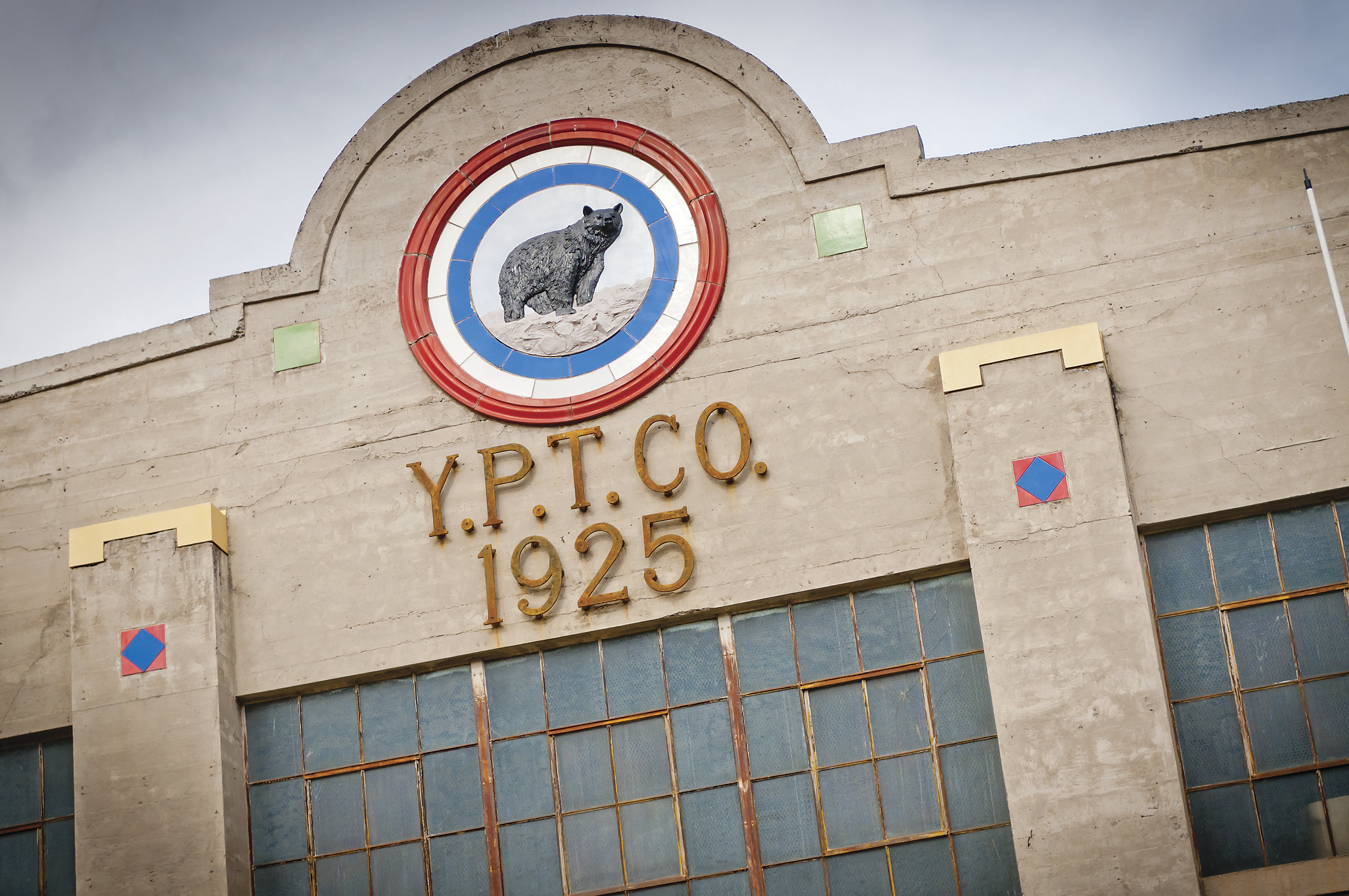
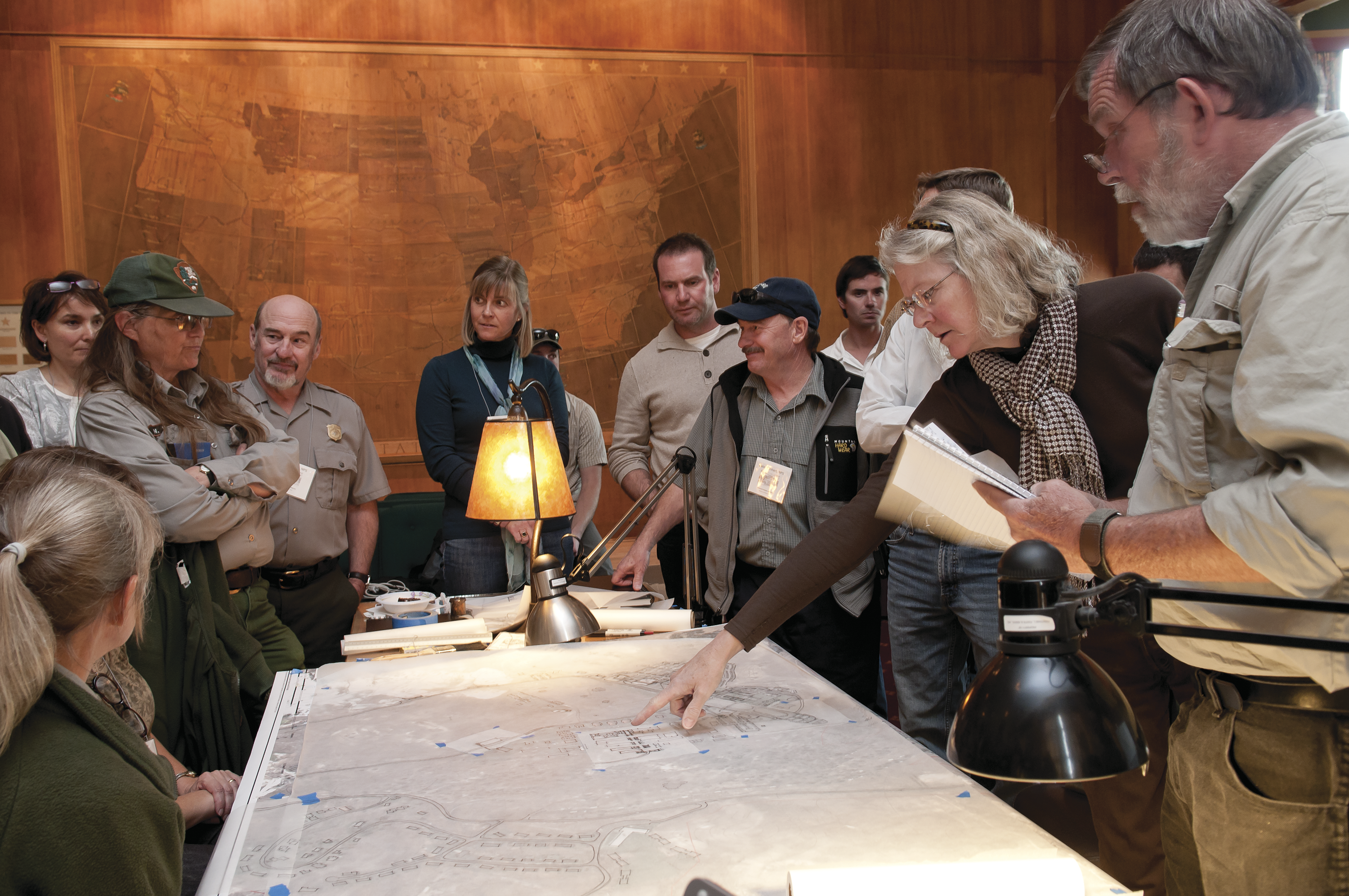

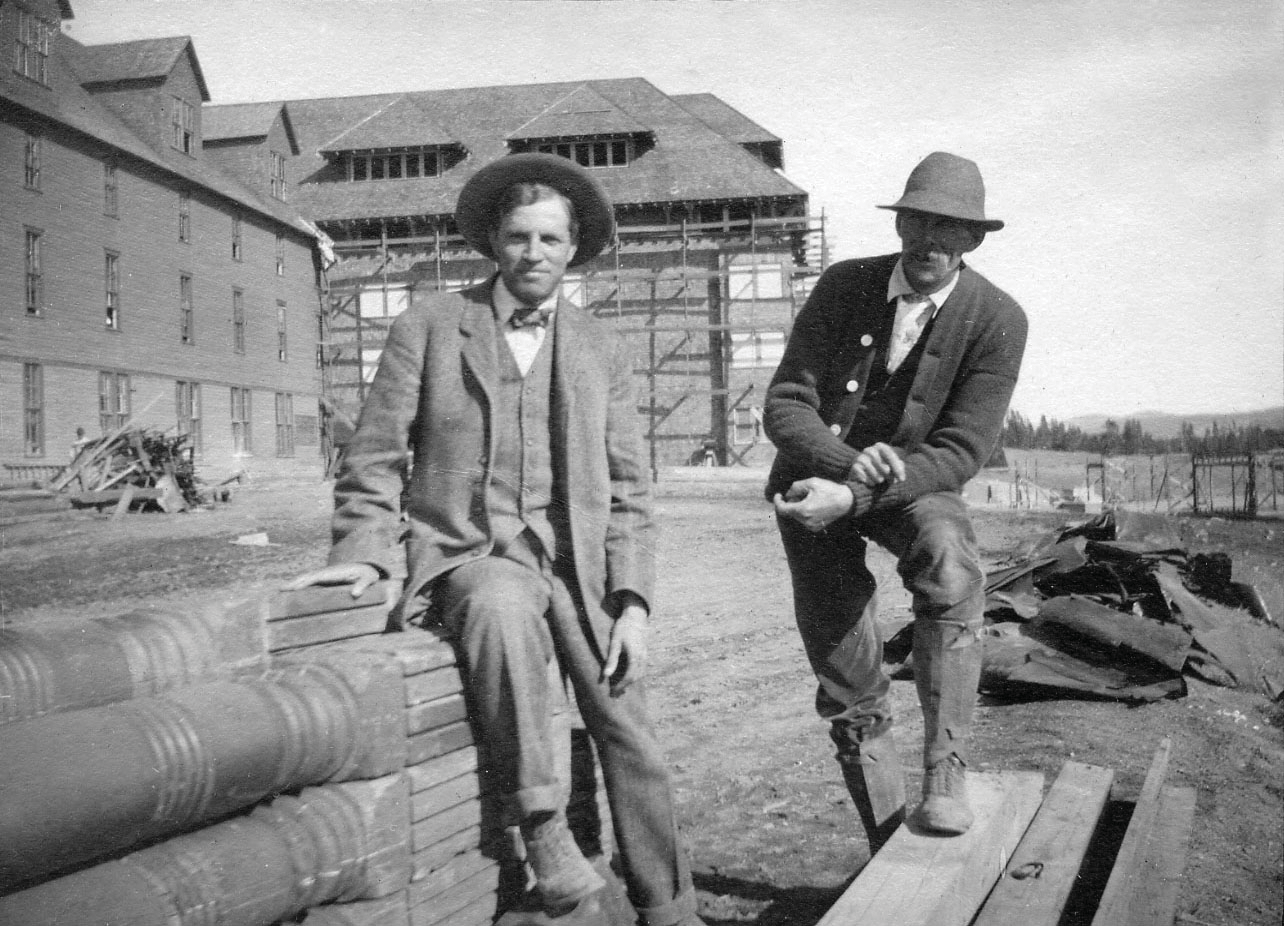
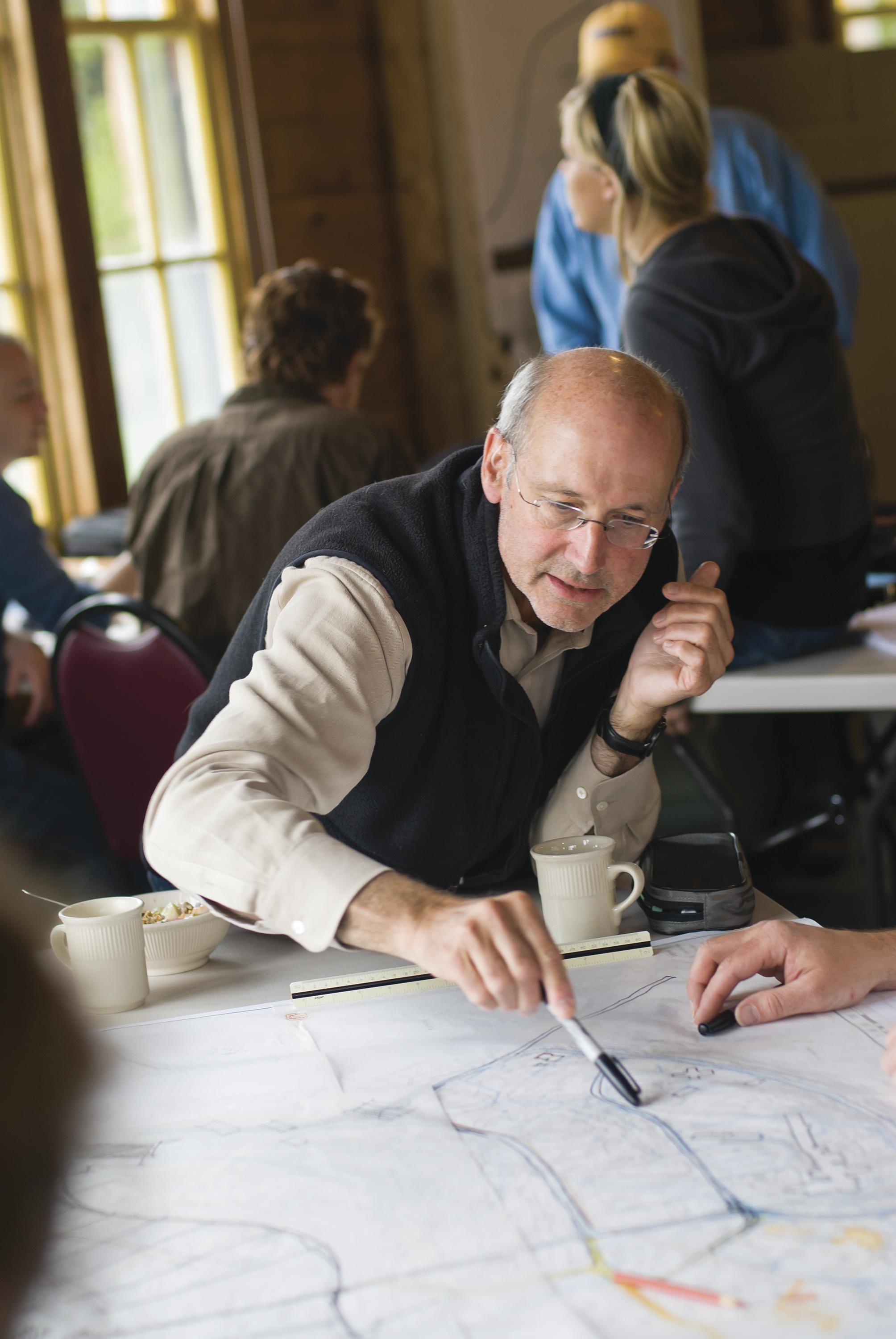

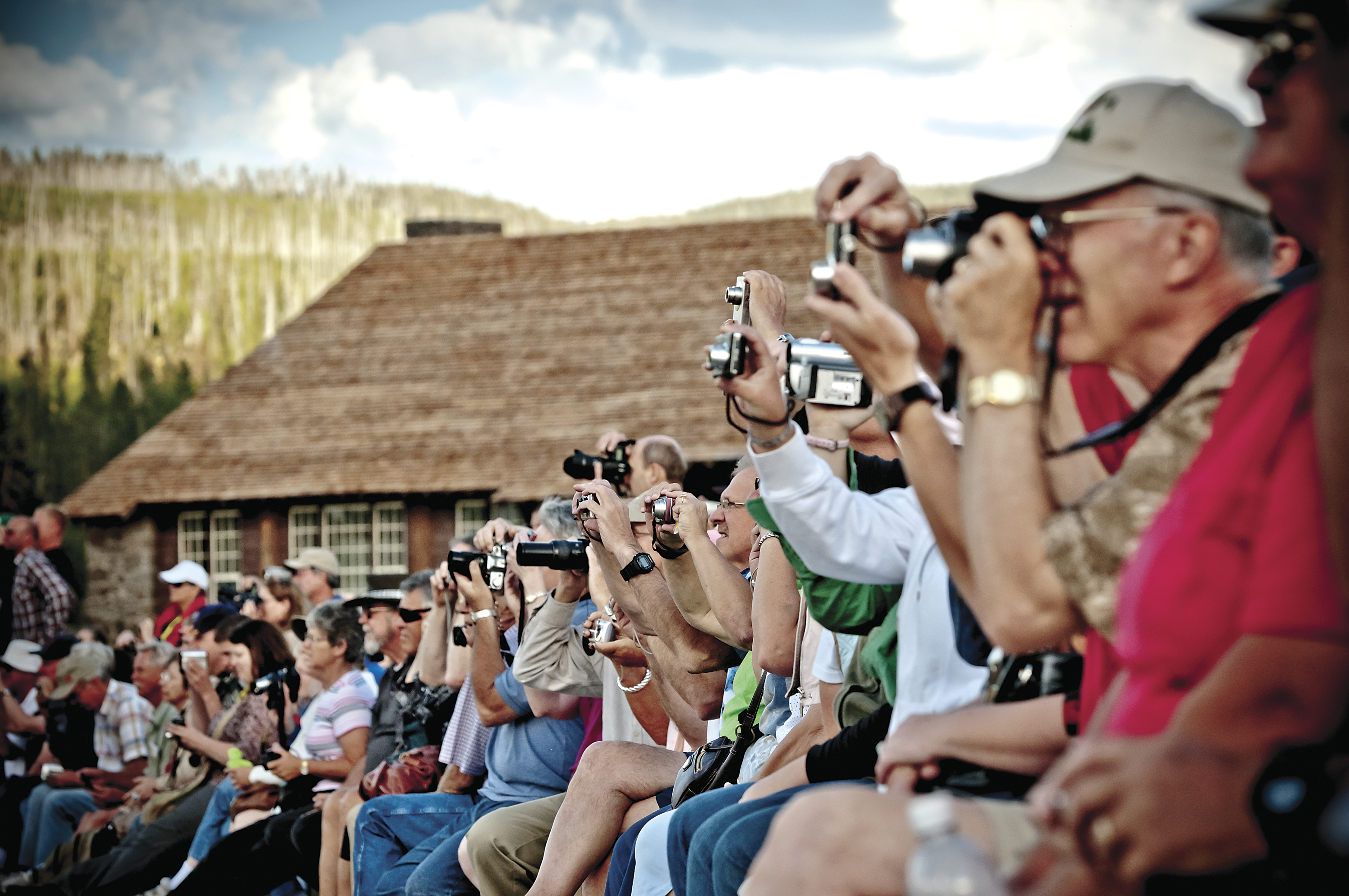

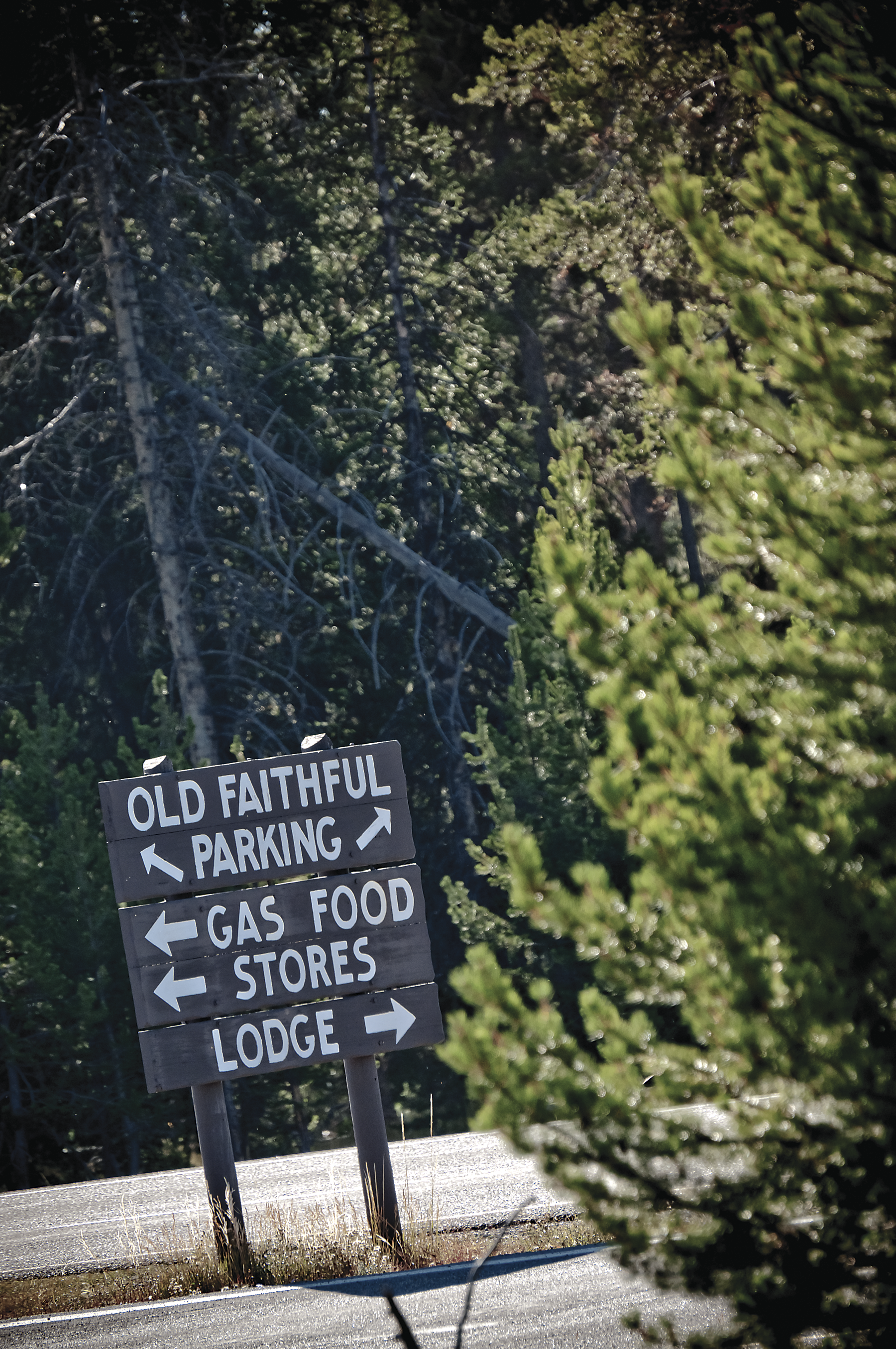

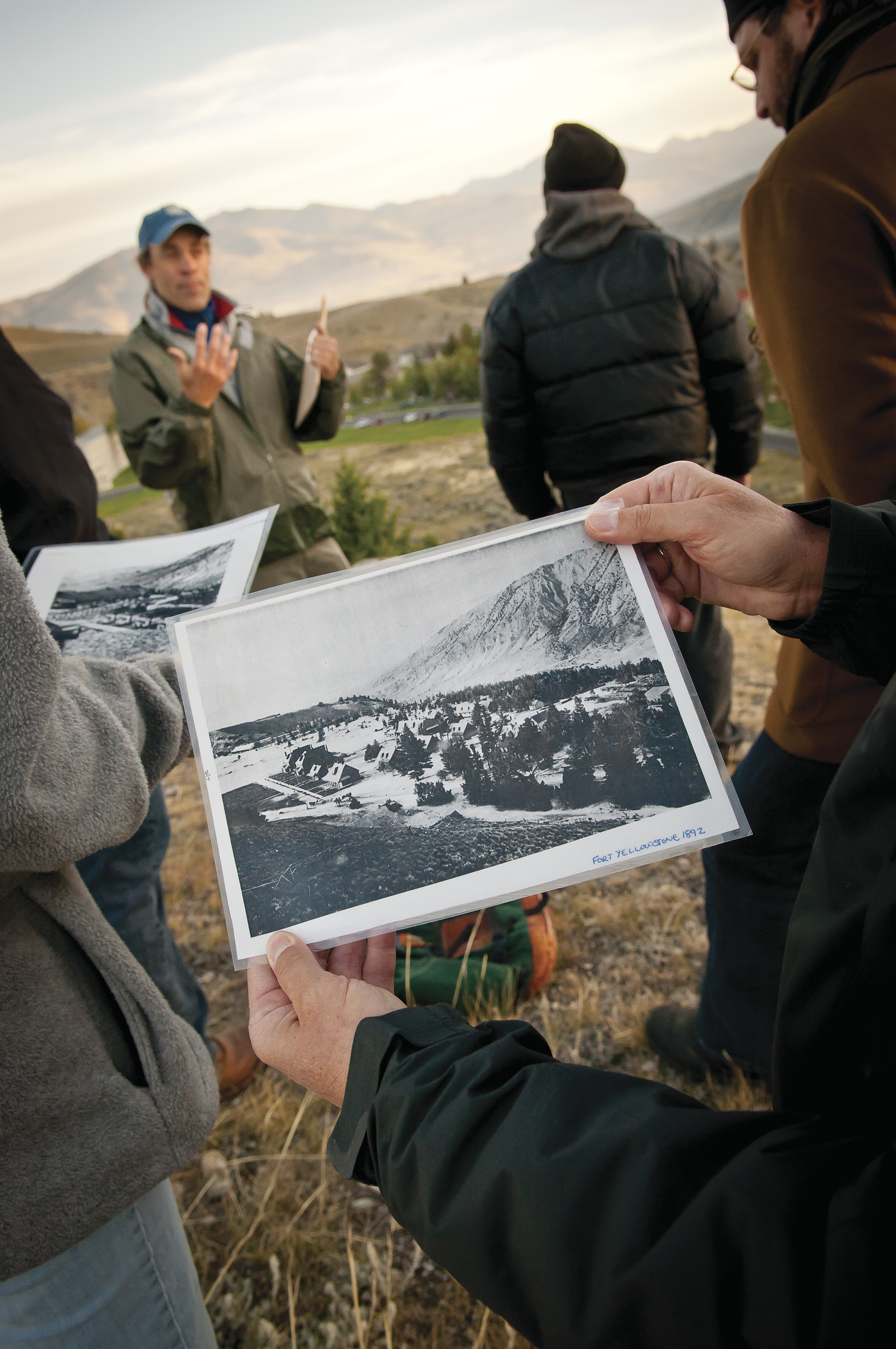
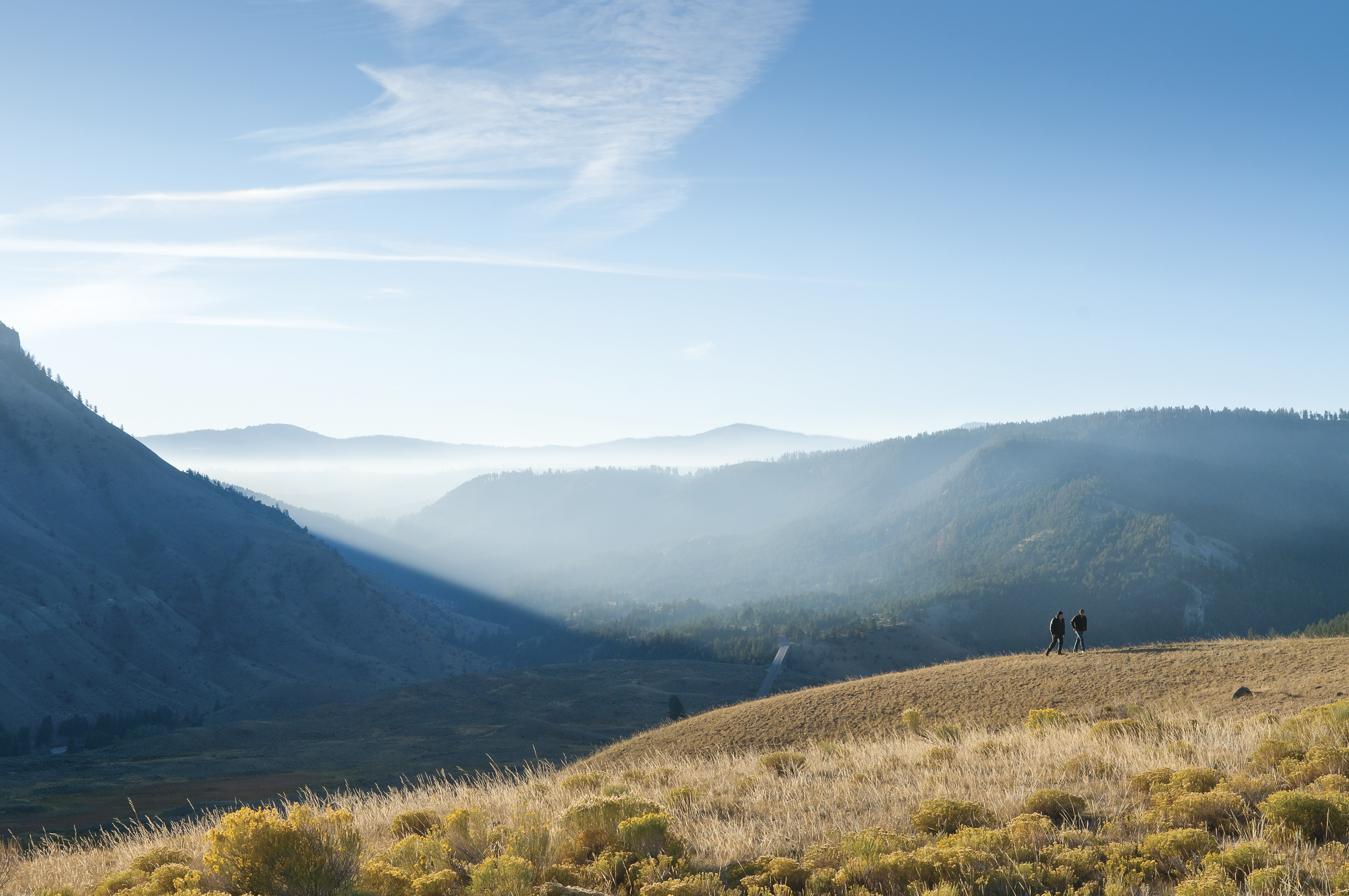
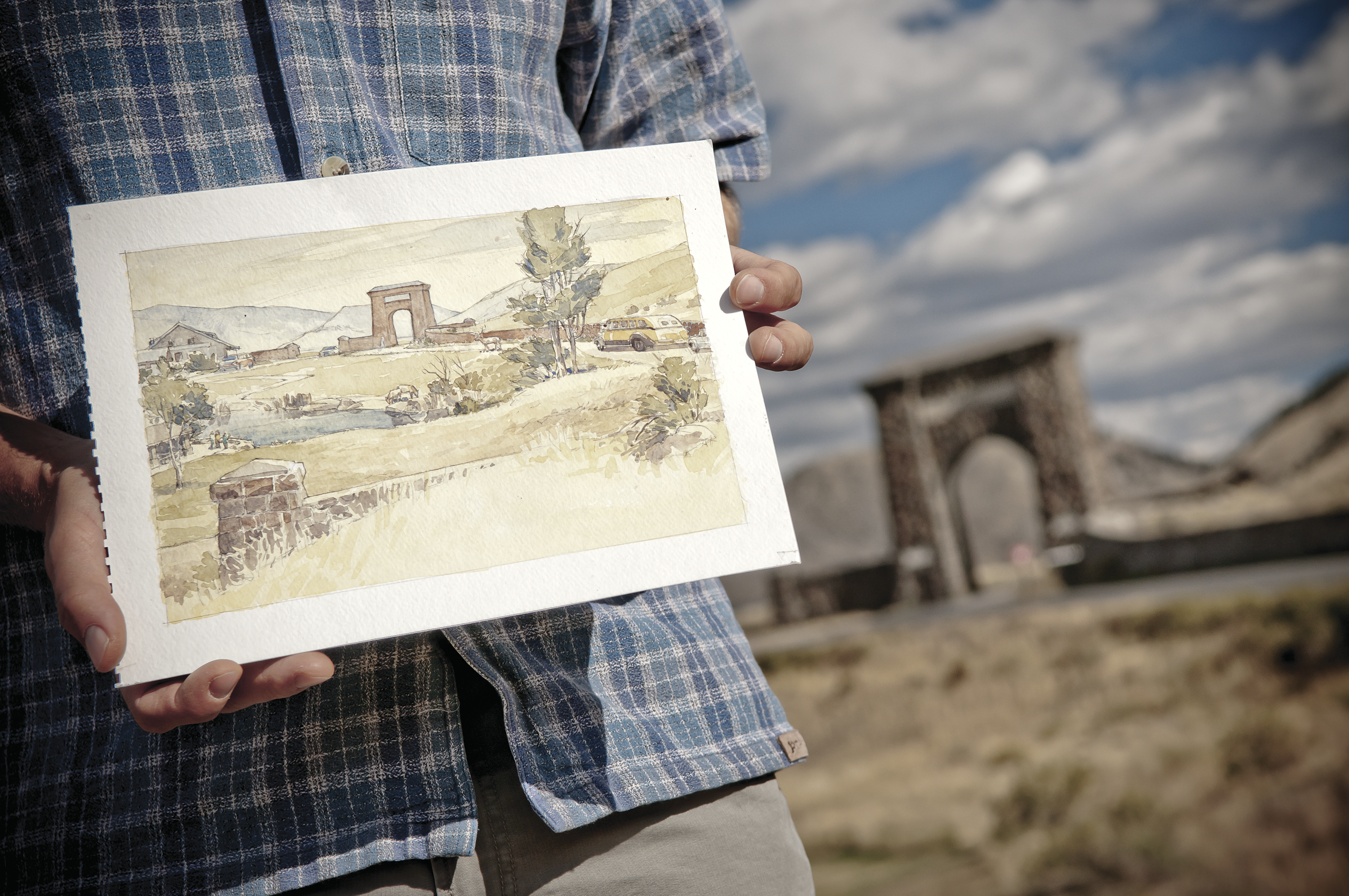
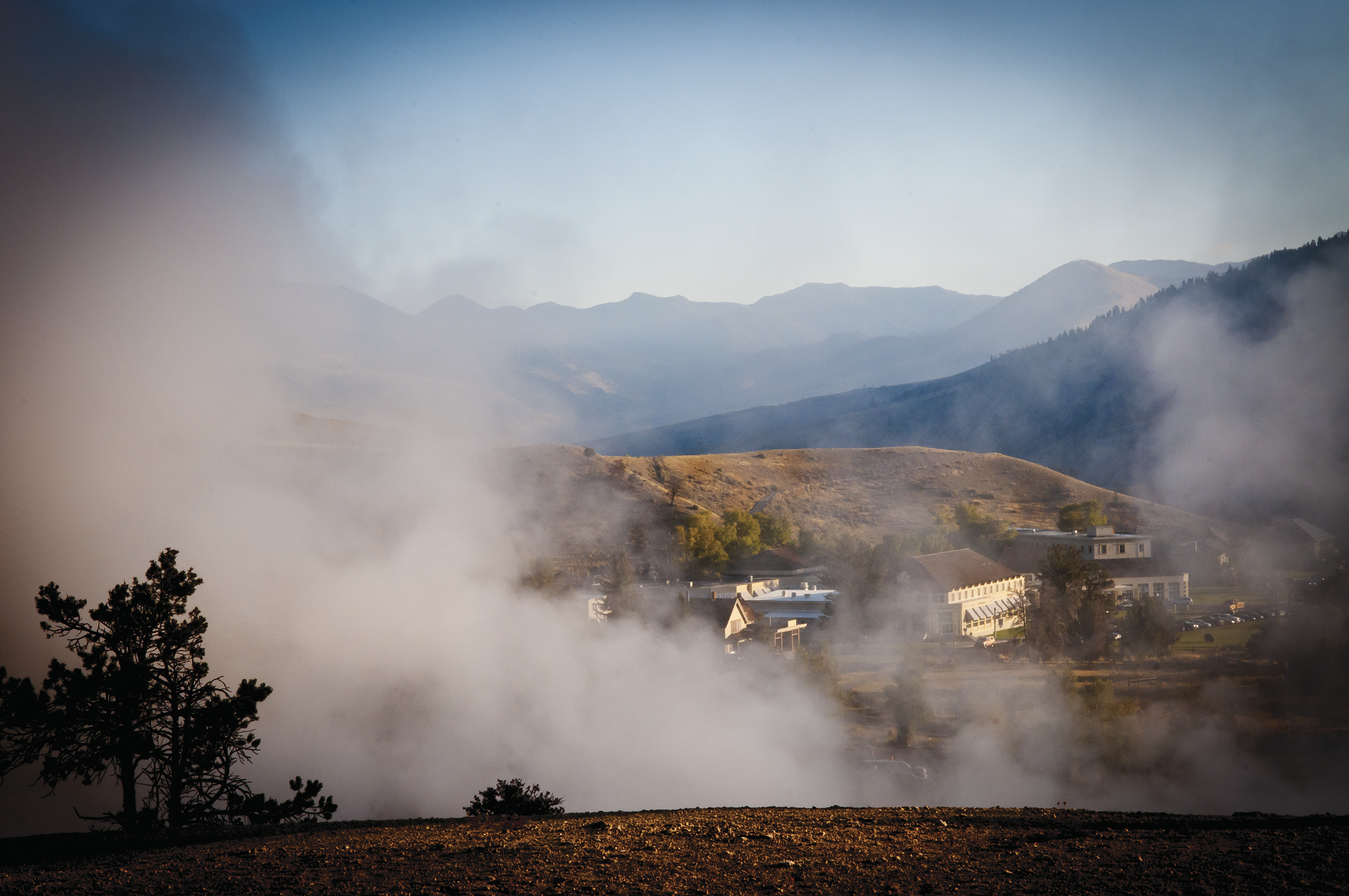

No Comments